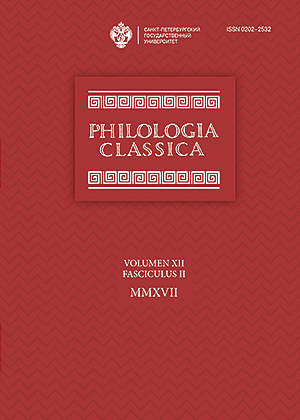On the Archaic Meaning of the Word filum in Apuleius
DOI:
https://doi.org/10.21638/11701/spbu20.2017.203Abstract
The paper discusses how the meaning ‘appearance, figure’ of the Latin word filum was developed in the pre-classical writers’ works and how the meaning in question was revived in the texts of later authors, especially in the writings of Apuleius. The present meaning is typical of Lucretius, as in his poem On the Nature of Things he regards bodies as an interweaving of atoms and describes them with terms from the weaving field. It was Lucretius whom Apuleius referred to speaking about the nature of daemons: fila corporum (De deo Soc. 11). The use of the word filum regarding human appearance could have developed as a metaphorical transfer from clothing to its owner. For the post-classical period writers this meaning was already unusual, and the word filum was often supplemented by the explicative words corporis or oris. The author makes an assumption that the word filum in reference to the human appearance enjoyed popularity in the post-classical literature due to its archaic color. A significant number of the same type expressions with the word filum in the given meaning (bono filo, decente filo, filo virginali etc.) are also pointing to the fact that these expressions were idiomatic.
Keywords:
archaic vocabulary, Apuleius, Lucretius, Latin idioms, weaving metaphors
Downloads
References
Downloads
Published
How to Cite
Issue
Section
License
Articles of "Philologia Classica" are open access distributed under the terms of the License Agreement with Saint Petersburg State University, which permits to the authors unrestricted distribution and self-archiving free of charge.






